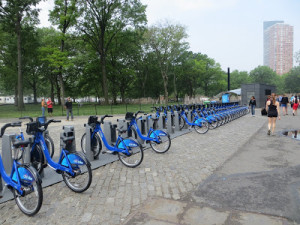Bike share programs have been popping up in lots of cities across the United States, and researchers are studying their pros and cons compared to private cycling, walking, driving, and public transit. One outstanding fact about bike share programs is that no one has died while using a bike share bike in the United States. Of course, we hope to keep it that way, which leads researchers to ask, what makes bike share programs so much safer, than, say, private bike cycling? This article looks at one study on bike share safety in Washington DC, Minneapolis, and San Francisco, and suggests some conclusions on what makes them so much safer.

PC: “Help Me Rhonda” Blogspot
First, bike design. Bike share bikes are built to be sturdy with wide tires, much more suited for driving down bumpy roads with the occasional pothole than slender bikes with thin tires. Second, the majority of bike share stations tend to be located in densely populated urban areas with heavy foot and bike traffic, which means drivers are generally more alert and paying close attention to others they share the road with. Finally, bike share users are often less experienced riders than bike owners, which might actually give them an advantage: they tend to be more defensive and more risk-adverse than those who are much more confident bikers.
NYC’s own Citi Bike share program has been on the rise since it began almost three years ago. According to AM New York’s article, neither snow storms nor freezing temperatures have slowed down Citi Bike users. During this past January’s almost record-breaking snowstorm, 509,000 Citi Bike rides took place (a 70% increase from the same time period in January, 2015). On half of the days this past February, the temperature reached below freezing, but 560,000 rides still took place, 184% higher than February last year!
The program is great for New Yorkers to commute to work and to incorporate exercise into their daily routines, and fun for tourists to travel around and explore the city. It also helps take cars off of the roads, which will help improve local air quality and reduce greenhouse gas emissions. As it becomes more and more popular, there is an increased demand for bike friendly infrastructure on the roads. No one wants pedestrians walking around in the street or cars driving on the sidewalks, so why shouldn’t bikers too have space designated for their use and designed for their own needs? Hopefully, bike share programs will help promote the creation and upkeep of bike lanes to keep all bikers, pedestrians and drivers safe.
